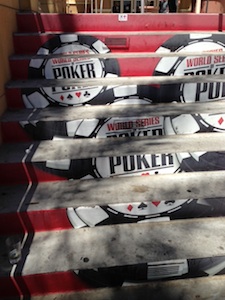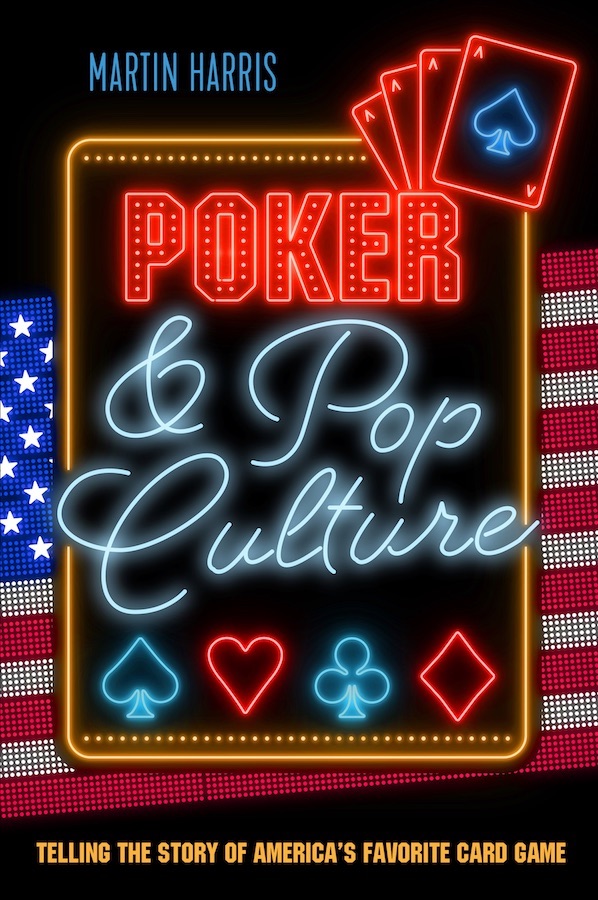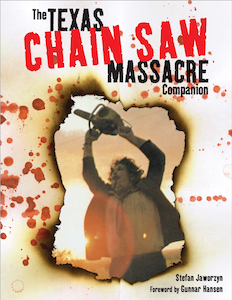Over the last few posts I keep bringing up the topic of “tradition” at the World Series of Poker, in particular the establishment of what has become a new tradition of sorts at the Rio All-Suite Hotel and Casino since the WSOP made its move there from Binion’s in the mid-2000s.
Now that I’m home from a sixth year of reporting from the WSOP, I’m becoming more conscious of my own traditions regarding my experiences there as well as how I’ve been communicating them on Hard-Boiled Poker. Am following one of those again today by compiling all of my “travel report”-type posts into one here, partly to have a single place to find all my 2013 WSOP-related posts and partly to enable me to move on mentally to something new going forward.
I noted in last year’s “Reporter’s Notebook” post how my HBP posts about the WSOP had become increasingly personal over the years, and I think that trend mostly continued this time around as well. You can check back to previous years -- 2008, 2009, 2010, 2011, 2012 -- and compare and then decide for yourself if that holds true.
To Vegas, Again! & Hello Vegas
A couple of preliminary posts coming just prior to departing for Las Vegas and soon after my arrival. Speaking mostly of the conspicuous signage for Ultimate Poker and WSOP.com that greets one at McCarran as well as a few early reunions with friends and colleagues in the latter.
2013 WSOP, Day 21: Min Cash, Max Fun
My first full day in Vegas was mostly spent playing a low buy-in ($125) event over at the Golden Nugget where I managed to make the money. Looking back I rue the missed opportunity to have gone deeper at the end, but in truth I was almost utterly spent mentally by the time I was felted some 11 hours after the sucker had begun.
2013 WSOP, Day 22: Step Right Up
I jumped quickly into the fray, helping report on the second day of Event No. 32, the $5,000 NLHE 6-max. event that featured many top players (both live and online). The post includes an interesting reference to T.J. Cloutier’s somewhat unusual bustout hand in the event that involved him miscalculating what an opponent had left behind.
2013 WSOP, Day 23: Divided Attention
Rather than finish out the $5K 6-max., I moved over to help with Day 2 of another event, the $3K PLO event (Event No. 35) which coincided with Game 7 of the NBA playoffs between the Miami Heat and the San Antonio Spurs. Players and media alike were greatly challenged to keep their minds on the cards as the game’s exciting conclusion played out on the big screens surrounding the tables.
2013 WSOP, Day 24: Year of the Player of the Year
2006 WSOP Player of the Year Jeff Madsen ended up winning Event No. 35, partly inspiring the title and focus of this post. Madsen, Tom Schneider, Daniel Negreanu, and Erick Lindgren -- all former WSOP POYs -- each won bracelets this summer (with Schneider winning two of them).
2013 WSOP, Day 25: Is That Who I Think It Is?
Moved over to cover another PLO event -- Event No. 41, the $5K PLO 6-max. -- and in this post was reflecting on seeing Sammy Farha making his 2013 WSOP debut and not recognizing him at first. Interestingly aside from that first day on the $5K NLHE 6-max., I would end up covering all non-hold’em events my entire time at the WSOP this summer until the Main Event arrived.
2013 WSOP, Day 26: Cold
Players complain every summer about how cold the conditions are in the spacious ballrooms where the WSOP is staged, but the complaints had become so prevalent by the midpoint of the Series this year the temps had become an unavoidable topic of conversation. And so I bundled up and talked about it as well.
2013 WSOP, Day 27: What Does This Stand For?
An amateur made the $5K PLO 6-max. final table, with some of his comments and actions adding to the fun of covering that event’s finale. I shared a little about him in this post while reflecting a little about how the WSOP means different things to different people.
2013 WSOP, Day 28: The Old-Timers’ Game
After working six days straight I had one off, and spent part of it sitting in on the afternoon low-limit hold’em game over at the Palms. As it would turn out, that’d be the only other poker I’d play this summer other than the Media tournament.
2013 WSOP, Day 29: Zombies, Bodies Sawed in Half, and Other Hallucinations
Vera Valmore arrived for a visit of a few days, and we had great fun going out to Red Rock Canyon as well as checking out the Penn & Teller show at the Rio.
2013 WSOP, Day 30: We Will Rock You
Somehow Vera had never taken in the “Fremont Experience,” and so we managed to get over there during the evening to enjoy the modest spectacle one finds there on a regular basis.
2013 WSOP, Day 31: Mixed Games, Vegetables
Back to work for me, as I was assigned to help with Event No. 50, the $2,500 10-Game Mix which caused me to reflect some on differences between flop, stud, and draw games.
2013 WSOP, Day 32: Heaps of Headlines
There was a lot going on at the WSOP as the final week prior to the Main Event began, and here I tried to make reference to all of the different events playing out as well as acknowledge I’d recently seen and reviewed the new online poker documentary BET RAISE FOLD.
2013 WSOP, Day 33: Doyle Takes a Seat
It was already July, and I’d moved over to help report on the first day of the $50K Poker Players Championship in which Doyle Brunson -- whose 80th birthday is coming up in August -- made his 2013 WSOP debut.
2013 WSOP, Day 34: Motoring Through
In this post I discussed continuing to help with the $50K PPC for another day, an event that not only attracts lots of poker’s best (and best-rolled) players, but is especially interesting to cover thanks to the increased “play” afforded by the event’s deep structure.
2013 WSOP, Day 35: Talking Tells
Got to enjoy another rare day off, this time spending part of it with Zach Elwood, author of Reading Poker Tells.
2013 WSOP, Day 36: Breaking a Hand
Once again I was covering a non-hold’em event, this time Event No. 59, the $2,500 2-7 Triple Draw. Found myself contemplating what is really a somewhat unique situation in poker, namely, the instance of a player “breaking a hand” in 2-7 (i.e., after having stood pat on an earlier round, deciding to draw on a subsequent one). Even went so far as to draw an analogy between breaking a hand in 2-7 and the detour I took career-wise that carried me away from one apparent destiny into a life of poker writing.
2013 WSOP, Day 37: Look Away
Here I briefly touch on a useful skill for tourney reporters to learn -- i.e., not to look when players squeeze their hole cards.
2013 WSOP, Day 38: Number One and Number Two
Eli Elezra ended up beating Daniel Negreanu heads up to win the bracelet in Event No. 59 ($2,500 2-7 Triple Draw), making the event even more fun to cover as both are not only great players but engaging personalities as well.
2013 WSOP, Day 39: Nitcast Meet-Up, Shuffling Up and Dealing, and Turtling Up
The Main Event began with the first of three Day 1 flights, and I reported a little on the scene as things got underway. Also had a fun time meeting with the Thinking Poker podcast hosts and some their guests and listeners on this day. Finally I joined the coverage of Event No. 61, the $10K PLO event in which NBA star Paul Pierce managed to stick around for much of Day 2 before busting shy of the cash.
2013 WSOP, Day 40: Connectivity
Sharing a little here about the wild finale of Event No. 61 that saw the tourney play down from 32 players to just one -- Daniel Alaei -- on a super long day that didn’t end until after 4 a.m.
2013 WSOP, Day 41: Where There’s Smoke
On July 1 lightning struck the side of Mt. Charleston, located about 35 miles northwest of Las Vegas, and a huge, out-of-control wildfire resulted. A week later I finally had a chance to get a good look at the massive waves of smoke visible from LV, and so shared some pictures and other reflections on the fire here. (Click that pic to the left to enlarge... frighteningly.) Also got to enjoy a fun dinner with
Pokerati Dan and his girlfriend Trish on this day.
2013 WSOP, Day 42: Running Good, Catching Hands
Finally joined the coverage of the 2013 WSOP Main Event, starting with Day 2a/2b. Here I talk about the tourney reporter’s travails when racing around amid a huge field looking for interesting hands to report.
2013 WSOP, Day 43: Folding Kings
Discussing Day 2c of the WSOP Main Event in this post, focusing in particular on a most interesting hand from very late in the day that saw Jackie Glazier fold pocket kings before the flop in the face of a Chris Tryba seven-bet. Indeed, he had aces, and the hand became all of the more interesting to consider in retrospect as Glazier would go on to finish 31st in the ME.
2013 WSOP, Day 44: Working in the Amazon
This is the post where I started talking about “tradition” and how the Rio has by now begun to establish itself as the home of the WSOP. I spent all but a couple of my working days this summer in the Amazon Room, and so used my post on this day as occasion to reflect on my “office” that I share every summer with thousands of others.
2013 WSOP, Day 45: The Past, the Future, and Doyle
Doyle Brunson cashed in this summer’s WSOP Main Event, finishing 409th. It marked the fifth decade he’s done so after having made the money in the ME in the 1970s, 1980s, 1990s, and 2000s, too. He hadn’t cashed in the ME since 2004, and when he was eliminated on Day 4 this year I suppose it went through the minds of many how it could be the last time he does. In any case, I couldn’t help but reflect a little on how inspiring Brunson continues to be to many of us.
2013 WSOP, Day 46: Finding a Final Nine
Day 5 of the Main Event saw the tournament play down to just 68 players, and already certain storylines were starting to emerge as we all began thinking about which nine might emerge to come back in November.
2013 WSOP, Day 47: The November Nine is Nigh
They quickly played down from 68 to 27 in just four levels on Day 6, which led to the decision to stop play a level early. Was looking for all the world like the young German player, Anton Morgenstern, had locked up a spot in the final nine as he enjoyed a big lead at the end of this day, but that proved not to be.
2013 WSOP, Day 48: The Last 633 Hands of the Summer
We did hand-for-hand reporting from the final three tables onward at PokerNews and thus reported on 633 hands as the tourney played down from 27 to nine. I talk some about Morgenstern’s fall, J.C. Tran’s rise, and other details of Day 7.
2013 WSOP, Postlude: Unfinished Business
Finally I added one last afterthought yesterday regarding my always leaving the WSOP before the Main Event has finished. I also reflected on that half-constructed building sitting within sight of the Rio parking lot that we’ve all seen over and over for the last several years -- which happens to have my name plastered on its side.
Thanks again to everyone who has taken the time to read some or all of these posts over the last month, which I hope added at least a little something extra to people’s enjoyment when following this year’s WSOP.
Labels: *high society, 2013 WSOP
























 .
. 













